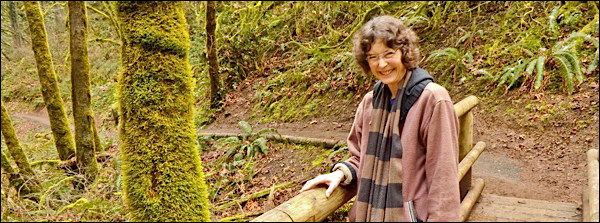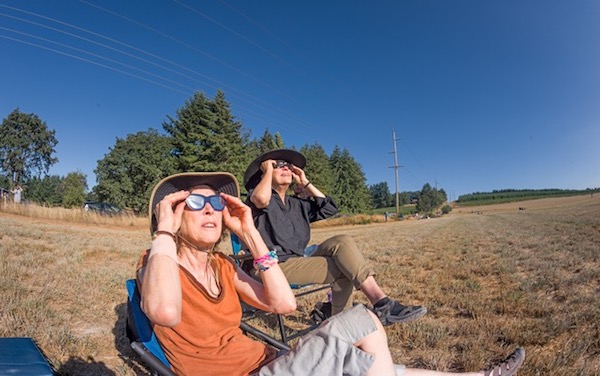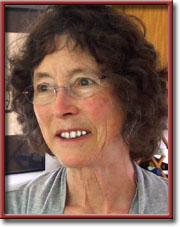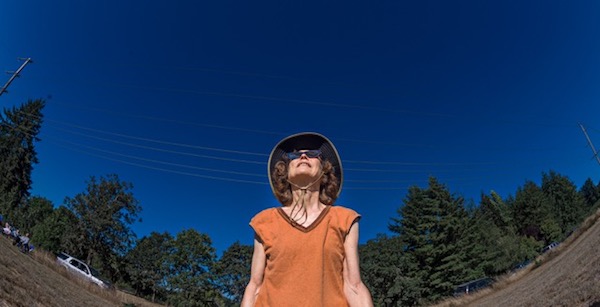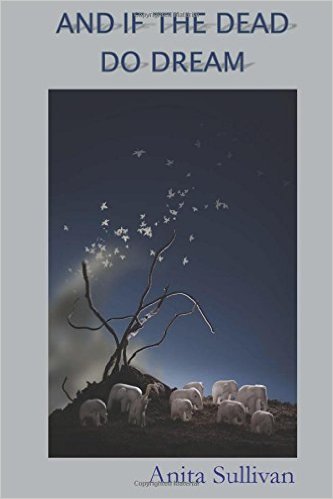The Summer of Two Eclipses (Best of Hubris)
“There we were, a bunch of strangers in a random field, all facing the same direction as if we were sitting on the beach. But our heads were tipped back and we were wearing these silly grey glasses that looked like we had cut them out of a coloring book. Almost as soon as we took our first peek, we could see a little black blob on the top right side of the sun! The moon was starting to swallow it. From that point on, I was gone, like everybody around me.”—Anita Sullivan
On the Other Hand
By Anita Sullivan
EUGENE Oregon—(Weekly Hubris)—(This column first ran in November 2017.)—Last night, I slipped out the front door shortly after dark to check on the moon. Statistically three days shy of full, the dear orb had entered that phase when it seems to sink into a terminal soporific roundness, as if this time it has truly and finally arrived, like a teenage emperor declaring in full arrogance, “I will never wane again!”
The not-quite moon fools me every month; I always think, “Surely tonight it’s full!” when, actually, I’ve missed it by two or three days, either side.
But last night’s round-ish moon looked sunken and ghastly, an unhealthy dark orange, not its usual crisp brilliant yellow. The moon is being choked like the rest of us by fires raging virtually unchecked along the forested central mountains of the Pacific Northwest from Canada through Washington and Oregon to the California border, and filling the skies on either side with their residual smoke. On a map, the fires could be a fatal wound gashed across the solar plexus of the world.
About four hours earlier, I had also slipped out the front door into the blast-furnace of the late afternoon, to check on the sun. It was round and orange and ghastly, exactly like the moon. You could look directly at it. As if these two beloved orbs had decided (la la la) to risk changing places, what fun! Time for a brand new myth.
Not only that, but the sun on this smoke-infested afternoon looked—in the raw—exactly the same as its earlier self had appeared to me through my glasses almost two weeks earlier: a smoldering dark orange circle in a corner of the sky. Today, I didn’t need my eclipse glasses, because the sun was being visually quashed by the relentless transformation of thousands of trees from solid into gas. Millions, actually. Far away in Houston, in Bangladesh, in Mumbai, they are dying by water; while in this corner of the world, fire is the preferred mode of destruction. We are well into our second eclipse of the summer.
Eclipse day itself, August 21, was festive. The all-clear weather report was balm to us Western Oregonians, perpetually jaded regarding clarity in the heavens—so millions of us once again traced out our secret plan for reaching the very best viewing spot, hoping the masses of other eager eclipse watchers, local or streaming into the state from north and south would never think of that particular place.
I had chosen to view the eclipse from Finley Wildlife Refuge, near Corvallis, Oregon, about an hour’s drive from my house. I love the refuge, have wandered its paths for decades alone or in the company of good friends, and I could envision a group of us sitting on the grass under the open sky gazing upwards. For me it would be like a personal ritual, to combine the geography of an almost holy place with the celestial event.
My younger son flew up from the Bay Area for the occasion and, along with a local close friend, the three of us set off at what seemed like an appropriately early hour, planning to take back roads to avoid what the news media had warned might turn major highways temporarily into parking lots.
We were feeling terminally hopeful by the time we reached the back entrance of the Refuge with nary a traffic jam (only a pesky detour that obviously had nothing to do with the sun). But there in folding chairs sat two patient Refuge employees presiding over the roped-off gravel drive with the dreaded sign “At Capacity.” And we, among the other Rejected Ones, turned back down the road until we came to an even-more-back entry into the Refuge. Time was running out, so we parked beside a handy stubble field (the hay had already been harvested) along with a dozen or so other cars, pulled out our folding chairs and blankets and cooler and blatantly jumped over the ditch and into some farmer’s private field to exercise our ancient viewing rights (rites).
There we were, a bunch of strangers in a random field, all facing the same direction as if we were sitting on the beach. But our heads were tipped back and we were wearing these silly grey glasses that looked like we had cut them out of a coloring book. Almost as soon as we took our first peek, we could see a little black blob on the top right side of the sun! The moon was starting to swallow it. From that point on, I was gone, like everybody around me.
Annie Dillard wrote the definitive account of what it’s like to view a total eclipse, in her essay “Total Eclipse” in the 1982 collection Teaching a Stone to Talk. Among other things, she made quite clear the difference between “total” and “partial” when it comes to eclipses: “A partial eclipse is very interesting. It bears almost no relation to a total eclipse. Seeing a partial eclipse bears the same relation to seeing a total eclipse as kissing a man does to marrying him, or as flying in an airplane does to falling out of an airplane.”
My son and friend and I elected to eschew the convenience of our own driveways, where we could have seen a 92 percent partial eclipse (for crying out loud), and opted to drive the extra hour to experience the full 100 percent option.
Several nights later, sitting with a bunch of poets and each of us recounting our “eclipse experience,” one turned to me and said, “I suppose you’re going to tell me there’s all the difference in the world between a partial and a total eclipse.” I nodded, gently so as not to seem smug. She sighed and rolled her eyes.
See, here’s the thing. With solar eclipses, “Total” is arrived at by leaps and bounds, not by gradual shimmying. It’s exponential. You’re sitting there in the field waiting for the moon to gobble up the sun. More and more and more of the sun goes under. Pretty soon, the sun looks like a crescent moon. You take off your eclipse glasses and look around you. Everything looks pretty normal, the colors have gotten a teensy bit weird, but you can still see shadows. “What though my substance be 85 percent blacked out—a mere trifle, a pesky fly crawling on my mighty surface—!” says the sun. “Just try to stop me from lighting up the world!”
It’s all in the final 1 percent. Now you see it, now you don’t. Poof! We were keeping track, but then we weren’t. It got colder; the light went all blue and silver. The light went crazy into an entire spectrum I have never seen before. It was downright embarrassing. The wind picked up—no, there had been no wind and now there was one. And then everybody saw their own: Total Eclipse.
What I saw was that the sun completely disappeared. Suddenly the sky was totally black where just seconds before there had been a tiny brilliant sliver of yellow at the bottom left. Now, nothing, nothing, nothing. Zip! I found myself yelling. And everybody around was howling and shouting. This lasted all of about 30 seconds (because we were at the very south end of the Total zone). For no more than a couple of seconds, I took off my glasses and looked directly at the sun. I saw what looked like a grey cataract completely covering its surface, but Sun was obviously pulsing away brightly on the other side of this flimsy curtain. Glasses back on, and total darkness up there again.
We count on the sun to be a certain way and no other.
In the following days I learned that everybody had a slightly different version of what took place “up there” during totality. Most people saw some sort of bright aura around the edges, and some even saw the famous “mountains of the moon,” a jagged pattern showing right at the rim where the two orbs were temporarily superimposed. I saw none of this. But now I’m hoping for a second chance. I hear there’s a total solar eclipse in the Tuamotu Archipelago in January 2019.
![]()
To order Anita Sullivan’s books, Ever After and/or And if the Dead Do Dream, click on the book covers below.

